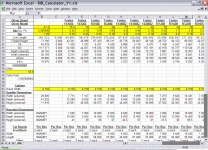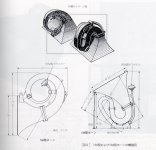Anybody knows what happened to BIB calculator? I was unable to download it from Zilla's site. If sombody has a copy, can you, please, e-mail to me?
vadim
vadim
Still have not got it. I wonder if Verizon cuts your e-mails. If this is the case, can you please, send it to my web site: vadimb@vbspeakers.com
Tank you,
Tank you,
GM,
To be honest, i'm not sure either. If you think this one works right, that's good enough for me. Can you please, e-mail it to me at the address in previous post?
I have a unique driver to design for and think this will work. It has Fs of 64.3 Hz, Vas of 50 liters and Qt of 0.72. It's a 10" coax. What do you think?
To be honest, i'm not sure either. If you think this one works right, that's good enough for me. Can you please, e-mail it to me at the address in previous post?
I have a unique driver to design for and think this will work. It has Fs of 64.3 Hz, Vas of 50 liters and Qt of 0.72. It's a 10" coax. What do you think?
YGM, two different calculators to choose from. 😉
Apparently it's not the right one or at least version since the #NAME fields don't work and the WS is PW protected, but it spits out all the right dimensions required to build one though.
The driver's specs are probably fine for a BIB, but it will have a large footprint and be too short for ceiling loading if you don't design using a lower Fs such as ~48.78 Hz which calculates T.C.'s driver location/folded height. If it's still too big, then just reduce Qts to slim down its footprint as required and accept the reduced LF if you want it to be a BIB.
GM
Apparently it's not the right one or at least version since the #NAME fields don't work and the WS is PW protected, but it spits out all the right dimensions required to build one though.
The driver's specs are probably fine for a BIB, but it will have a large footprint and be too short for ceiling loading if you don't design using a lower Fs such as ~48.78 Hz which calculates T.C.'s driver location/folded height. If it's still too big, then just reduce Qts to slim down its footprint as required and accept the reduced LF if you want it to be a BIB.
GM
Thank you Gregg.
I think the second one was the one on the web site.
Yes, the calculated box is huge. Is this because of high Q?
Another question: can I opt for much less baffle width and pay for that in depth? Is there a drawback to this?
Its been several years since I've paid for and used Martin's worksheets. Does he have one for BIB now?
I think the second one was the one on the web site.
Yes, the calculated box is huge. Is this because of high Q?
Another question: can I opt for much less baffle width and pay for that in depth? Is there a drawback to this?
Its been several years since I've paid for and used Martin's worksheets. Does he have one for BIB now?
You're welcome!
Yeah, it 'looks' like it would be, just didn't notice it as such initially when browsing my BIB folder. Don't know if it's the latest version though since it's older than the first one, so went through it and made a few minor changes, hence the 'v2a'.
Correct, effective motor strength dominates net cab Vb since the weaker the motor [higher Qts] the higher the cab's air mass spring's compliance must be to balance it out and vice versa.
You can, though like with any duct there's a point where its aspect ratio becomes high enough to add a resistive [friction] component that shortens its effective path-length, raising its resonance.
Around 9:1 is the one I've seen most often published and what WE appears to have used for its most extreme bends, but experience dating back to at least Roman times [and probably even earlier] has shown that it's in the bend where the losses begin at a much lower aspect ratio, so if you're going to go this route, you want to make it wider than deep and relocate the driver to its 'side'.
Also, from the examples we see that as the bend radius tightens up, maintaining [or at least not reversing] the expansion is imperative to ensuring a smooth, max gain response, i.e. the BIB's internal baffle can no longer be centrally terminated in its bend, but offset. How much though, you'll have to either work it out empirically as I've historically done or with a suitable Cad program or find/work through the math behind it.
So I've read, but check his site to be sure as all mine are long out of date.
GM
Yeah, it 'looks' like it would be, just didn't notice it as such initially when browsing my BIB folder. Don't know if it's the latest version though since it's older than the first one, so went through it and made a few minor changes, hence the 'v2a'.
Correct, effective motor strength dominates net cab Vb since the weaker the motor [higher Qts] the higher the cab's air mass spring's compliance must be to balance it out and vice versa.
You can, though like with any duct there's a point where its aspect ratio becomes high enough to add a resistive [friction] component that shortens its effective path-length, raising its resonance.
Around 9:1 is the one I've seen most often published and what WE appears to have used for its most extreme bends, but experience dating back to at least Roman times [and probably even earlier] has shown that it's in the bend where the losses begin at a much lower aspect ratio, so if you're going to go this route, you want to make it wider than deep and relocate the driver to its 'side'.
Also, from the examples we see that as the bend radius tightens up, maintaining [or at least not reversing] the expansion is imperative to ensuring a smooth, max gain response, i.e. the BIB's internal baffle can no longer be centrally terminated in its bend, but offset. How much though, you'll have to either work it out empirically as I've historically done or with a suitable Cad program or find/work through the math behind it.
So I've read, but check his site to be sure as all mine are long out of date.
GM
Attachments
Hi, I am interested also to see a BIB project. The Zilla web site is down, and I sent a few messages to him but not answer yet. Anyone that could kindly send to me the calculator or at least the formulas calculation. Thanks
Thanks to Dave p10 for posting it on another thread: http://www.diyaudio.com/forums/atta...sures-hemptone-fr8-bib_calculator_v1x.xls.zip
GM
GM
You're welcome! Yes, it's the one that normally is on Godzilla's website except that it's unlocked to work correctly on more types of systems, so best to save it as a master and make a copy to use in case it accidentally gets corrupted.
GM
GM
I just emailed several BIB calculators. Please report back your results if you build BIBs... mine are playing as we speak.
You can download the BIB Calculator from this link:
https://sites.google.com/site/speakerprojects/enclosures/bib
Zilla
https://sites.google.com/site/speakerprojects/enclosures/bib
Zilla
BIB calculaor
Also found by clicking on:
http://www.diyaudio.com/forums/full-range/233720-just-found-bib-design.html#post3446640
Scroll down to post #9
You can download the BIB Calculator from this link:
https://sites.google.com/site/speakerprojects/enclosures/bib
Zilla
Also found by clicking on:
http://www.diyaudio.com/forums/full-range/233720-just-found-bib-design.html#post3446640
Scroll down to post #9
- Status
- Not open for further replies.
- Home
- Loudspeakers
- Full Range
- BIB calculator


